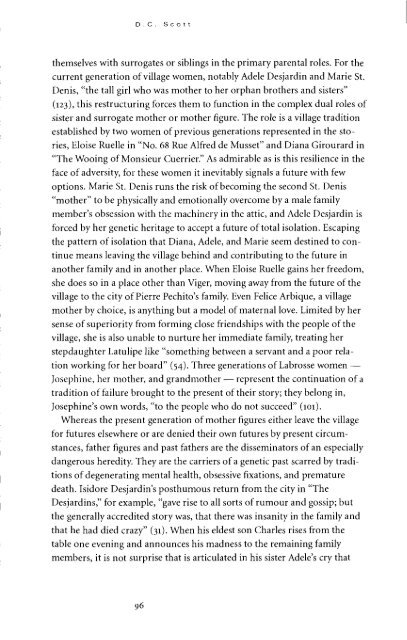The Carpathians - University of British Columbia
The Carpathians - University of British Columbia
The Carpathians - University of British Columbia
You also want an ePaper? Increase the reach of your titles
YUMPU automatically turns print PDFs into web optimized ePapers that Google loves.
themselves with surrogates or siblings in the primary parental roles. For the<br />
current generation <strong>of</strong> village women, notably Adèle Desjardin and Marie St.<br />
Denis, "the tall girl who was mother to her orphan brothers and sisters"<br />
(123), this restructuring forces them to function in the complex dual roles <strong>of</strong><br />
sister and surrogate mother or mother figure. <strong>The</strong> role is a village tradition<br />
established by two women <strong>of</strong> previous generations represented in the stories,<br />
Eloise Ruelle in "No. 68 Rue Alfred de Musset" and Diana Girourard in<br />
"<strong>The</strong> Wooing <strong>of</strong> Monsieur Cuerrier." As admirable as is this resilience in the<br />
face <strong>of</strong> adversity, for these women it inevitably signals a future with few<br />
options. Marie St. Denis runs the risk <strong>of</strong> becoming the second St. Denis<br />
"mother" to be physically and emotionally overcome by a male family<br />
member's obsession with the machinery in the attic, and Adclc Desjardin is<br />
forced by her genetic heritage to accept a future <strong>of</strong> total isolation. Escaping<br />
the pattern <strong>of</strong> isolation that Diana, Adele, and Marie seem destined to continue<br />
means leaving the village behind and contributing to the future in<br />
another family and in another place. When Eloise Ruelle gains her freedom,<br />
she does so in a place other than Viger, moving away from the future <strong>of</strong> the<br />
village to the city <strong>of</strong> Pierre Pechito's family. Even Felice Arbique, a village<br />
mother by choice, is anything but a model <strong>of</strong> maternal love. Limited by her<br />
sense <strong>of</strong> superiority from forming close friendships with the people <strong>of</strong> the<br />
village, she is also unable to nurture her immediate family, treating her<br />
stepdaughter Latulipe like "something between a servant and a poor relation<br />
working for her board" (54). Three generations <strong>of</strong> Labrosse women —<br />
Josephine, her mother, and grandmother — represent the continuation <strong>of</strong> a<br />
tradition <strong>of</strong> failure brought to the present <strong>of</strong> their story; they belong in,<br />
Josephine's own words, "to the people who do not succeed" (101).<br />
Whereas the present generation <strong>of</strong> mother figures either leave the village<br />
for futures elsewhere or are denied their own futures by present circumstances,<br />
father figures and past fathers are the disseminators <strong>of</strong> an especially<br />
dangerous heredity. <strong>The</strong>y are the carriers <strong>of</strong> a genetic past scarred by traditions<br />
<strong>of</strong> degenerating mental health, obsessive fixations, and premature<br />
death. Isidore Desjardin's posthumous return from the city in "<strong>The</strong><br />
Desjardins," for example, "gave rise to all sorts <strong>of</strong> rumour and gossip; but<br />
the generally accredited story was, that there was insanity in the family and<br />
that he had died crazy" (31). When his eldest son Charles rises from the<br />
table one evening and announces his madness to the remaining family<br />
members, it is not surprise that is articulated in his sister Adele's cry that

















